Literature Review: Intravenous vs. Inhaled Anesthesia & Pediatric EA
VerifiedAdded on 2023/06/14
|71
|15659
|440
Literature Review
AI Summary
This extended literature review investigates the effectiveness of total intravenous anesthesia (TIVA) compared to inhalational anesthesia (IA) in reducing emergence agitation (EA) among pediatric patients. The review addresses the research question of whether inhaled anesthetics increase the incidence of EA compared to intravenous anesthetics. A focused literature search identified nine relevant randomized controlled trials, with most studies suggesting that inhaled anesthetics are associated with a higher incidence of EA. The review highlights the need for further well-constructed studies to provide valuable clinical information and potentially support changes in practice. It covers background information on EA, its risk factors, and the mechanisms of action of different anesthetic agents, including propofol, sevoflurane, and others. The review concludes that while current evidence suggests a link between inhaled anesthetics and increased EA, more research is necessary to confirm these findings and optimize anesthetic approaches for pediatric patients.
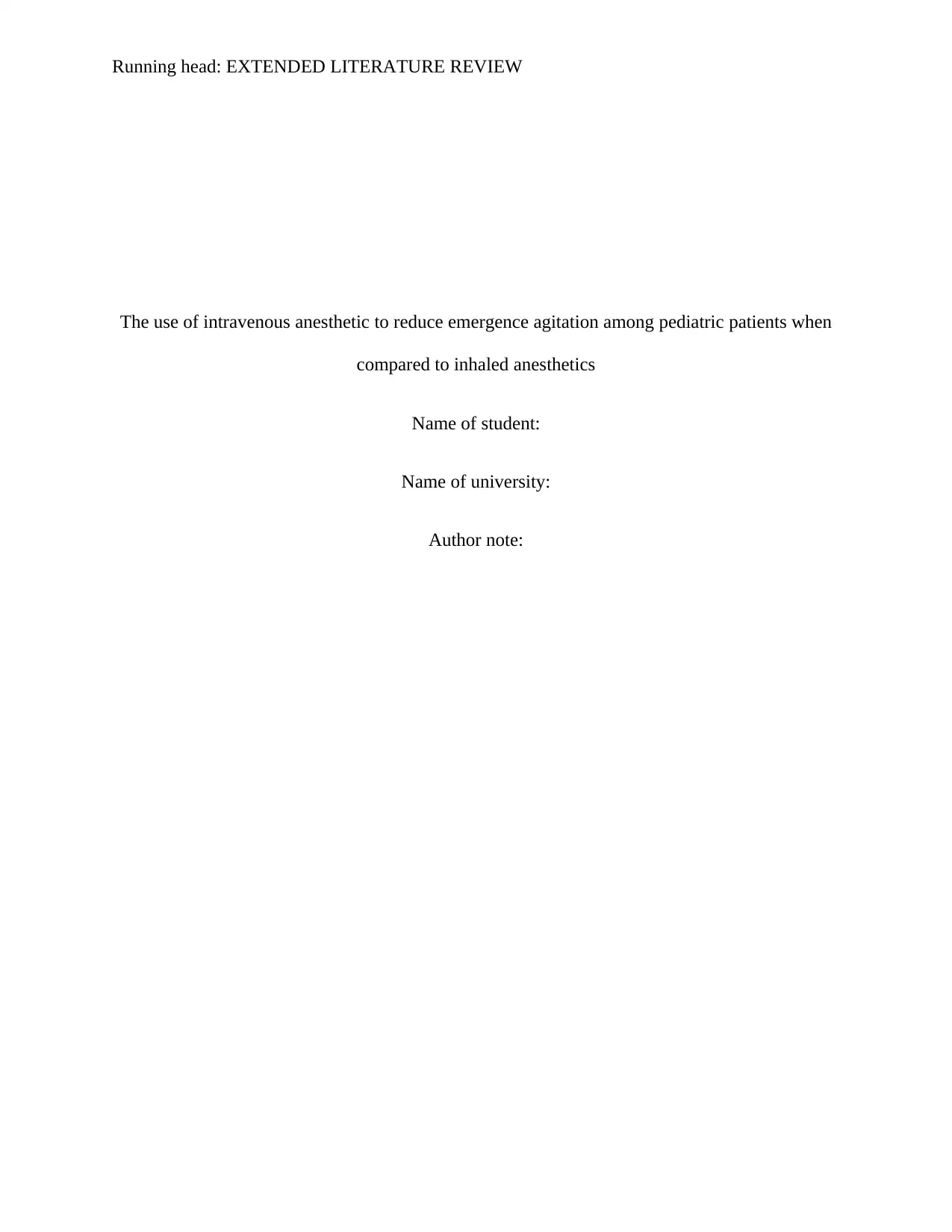
Running head: EXTENDED LITERATURE REVIEW
The use of intravenous anesthetic to reduce emergence agitation among pediatric patients when
compared to inhaled anesthetics
Name of student:
Name of university:
Author note:
The use of intravenous anesthetic to reduce emergence agitation among pediatric patients when
compared to inhaled anesthetics
Name of student:
Name of university:
Author note:
Paraphrase This Document
Need a fresh take? Get an instant paraphrase of this document with our AI Paraphraser
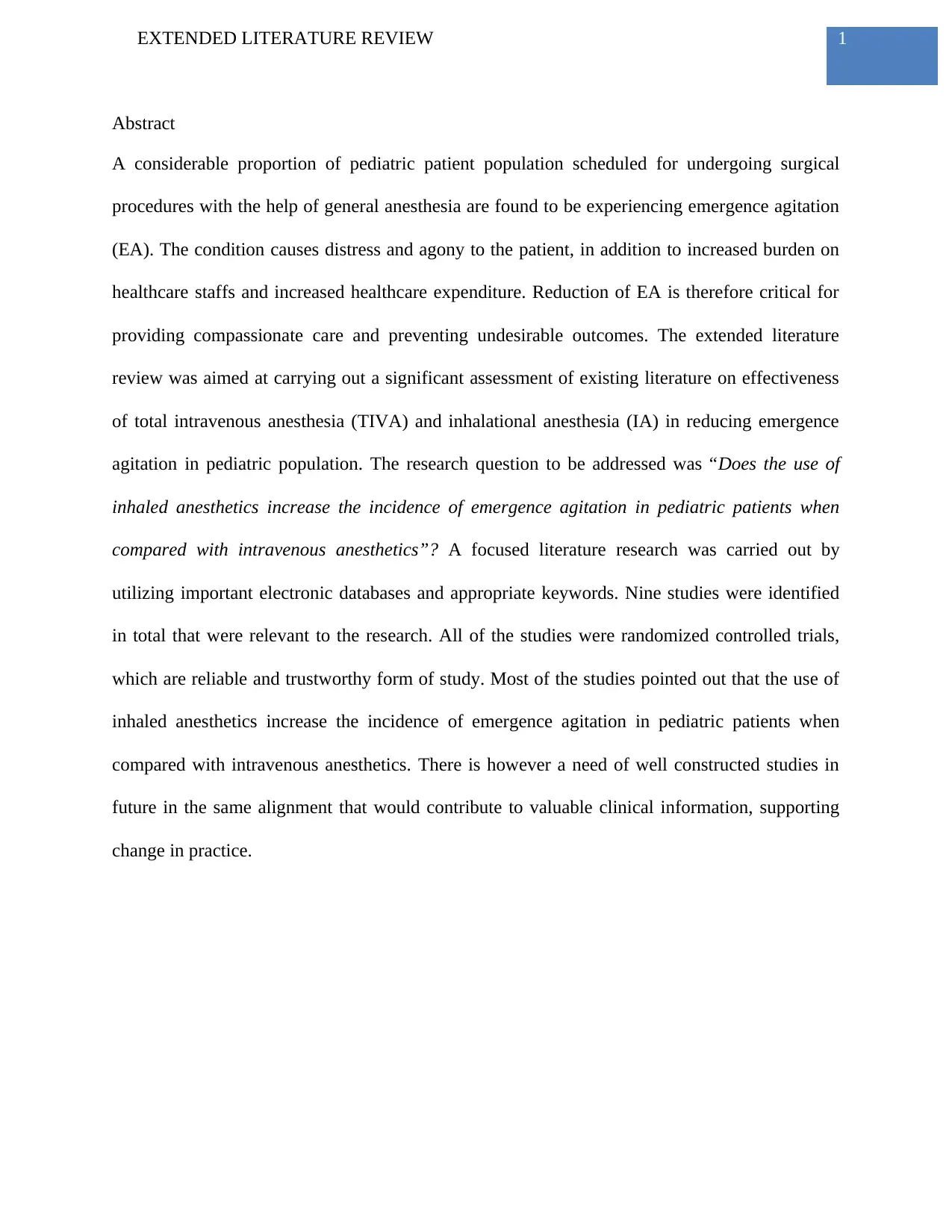
1EXTENDED LITERATURE REVIEW
Abstract
A considerable proportion of pediatric patient population scheduled for undergoing surgical
procedures with the help of general anesthesia are found to be experiencing emergence agitation
(EA). The condition causes distress and agony to the patient, in addition to increased burden on
healthcare staffs and increased healthcare expenditure. Reduction of EA is therefore critical for
providing compassionate care and preventing undesirable outcomes. The extended literature
review was aimed at carrying out a significant assessment of existing literature on effectiveness
of total intravenous anesthesia (TIVA) and inhalational anesthesia (IA) in reducing emergence
agitation in pediatric population. The research question to be addressed was “Does the use of
inhaled anesthetics increase the incidence of emergence agitation in pediatric patients when
compared with intravenous anesthetics”? A focused literature research was carried out by
utilizing important electronic databases and appropriate keywords. Nine studies were identified
in total that were relevant to the research. All of the studies were randomized controlled trials,
which are reliable and trustworthy form of study. Most of the studies pointed out that the use of
inhaled anesthetics increase the incidence of emergence agitation in pediatric patients when
compared with intravenous anesthetics. There is however a need of well constructed studies in
future in the same alignment that would contribute to valuable clinical information, supporting
change in practice.
Abstract
A considerable proportion of pediatric patient population scheduled for undergoing surgical
procedures with the help of general anesthesia are found to be experiencing emergence agitation
(EA). The condition causes distress and agony to the patient, in addition to increased burden on
healthcare staffs and increased healthcare expenditure. Reduction of EA is therefore critical for
providing compassionate care and preventing undesirable outcomes. The extended literature
review was aimed at carrying out a significant assessment of existing literature on effectiveness
of total intravenous anesthesia (TIVA) and inhalational anesthesia (IA) in reducing emergence
agitation in pediatric population. The research question to be addressed was “Does the use of
inhaled anesthetics increase the incidence of emergence agitation in pediatric patients when
compared with intravenous anesthetics”? A focused literature research was carried out by
utilizing important electronic databases and appropriate keywords. Nine studies were identified
in total that were relevant to the research. All of the studies were randomized controlled trials,
which are reliable and trustworthy form of study. Most of the studies pointed out that the use of
inhaled anesthetics increase the incidence of emergence agitation in pediatric patients when
compared with intravenous anesthetics. There is however a need of well constructed studies in
future in the same alignment that would contribute to valuable clinical information, supporting
change in practice.
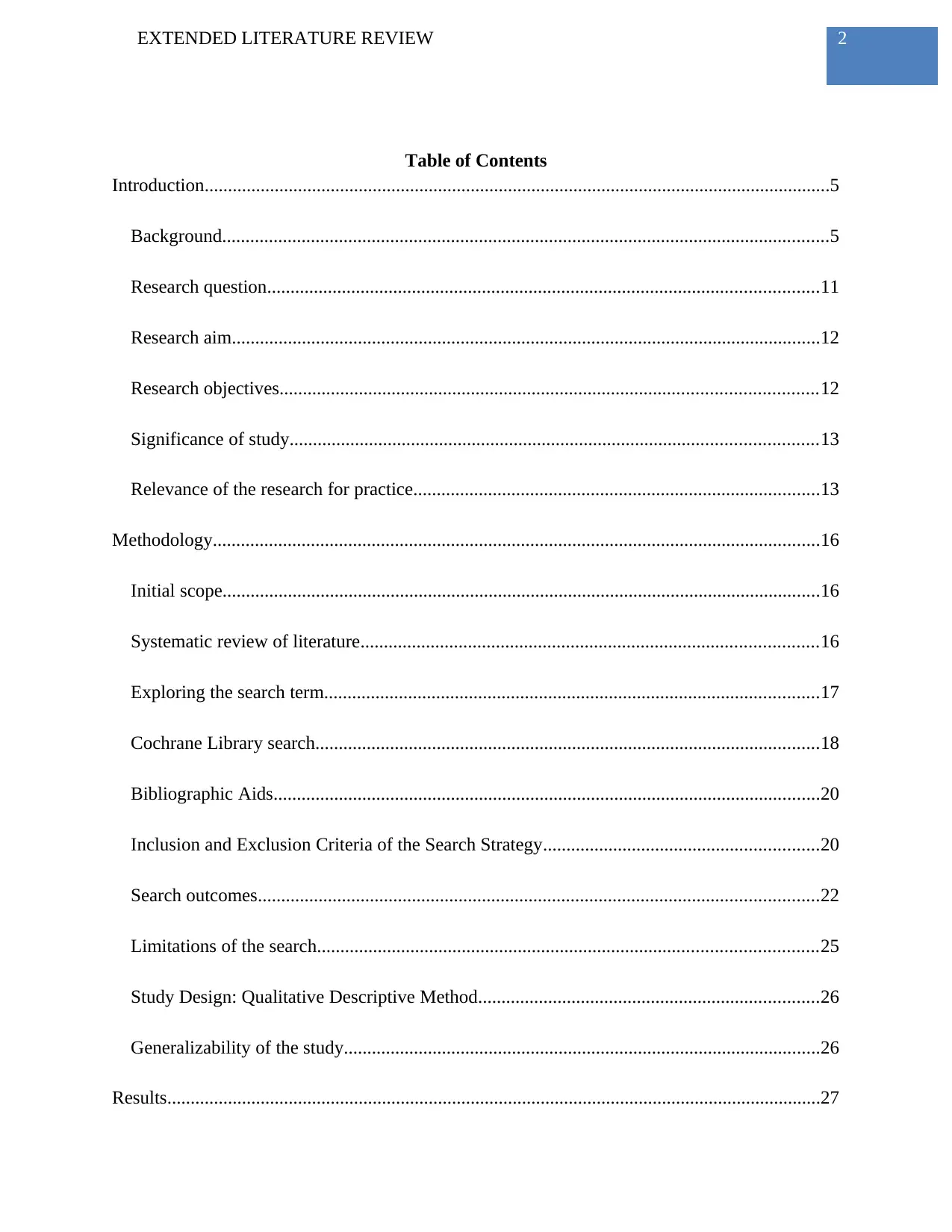
2EXTENDED LITERATURE REVIEW
Table of Contents
Introduction......................................................................................................................................5
Background..................................................................................................................................5
Research question......................................................................................................................11
Research aim..............................................................................................................................12
Research objectives...................................................................................................................12
Significance of study.................................................................................................................13
Relevance of the research for practice.......................................................................................13
Methodology..................................................................................................................................16
Initial scope................................................................................................................................16
Systematic review of literature..................................................................................................16
Exploring the search term..........................................................................................................17
Cochrane Library search............................................................................................................18
Bibliographic Aids.....................................................................................................................20
Inclusion and Exclusion Criteria of the Search Strategy...........................................................20
Search outcomes........................................................................................................................22
Limitations of the search...........................................................................................................25
Study Design: Qualitative Descriptive Method.........................................................................26
Generalizability of the study......................................................................................................26
Results............................................................................................................................................27
Table of Contents
Introduction......................................................................................................................................5
Background..................................................................................................................................5
Research question......................................................................................................................11
Research aim..............................................................................................................................12
Research objectives...................................................................................................................12
Significance of study.................................................................................................................13
Relevance of the research for practice.......................................................................................13
Methodology..................................................................................................................................16
Initial scope................................................................................................................................16
Systematic review of literature..................................................................................................16
Exploring the search term..........................................................................................................17
Cochrane Library search............................................................................................................18
Bibliographic Aids.....................................................................................................................20
Inclusion and Exclusion Criteria of the Search Strategy...........................................................20
Search outcomes........................................................................................................................22
Limitations of the search...........................................................................................................25
Study Design: Qualitative Descriptive Method.........................................................................26
Generalizability of the study......................................................................................................26
Results............................................................................................................................................27
⊘ This is a preview!⊘
Do you want full access?
Subscribe today to unlock all pages.

Trusted by 1+ million students worldwide
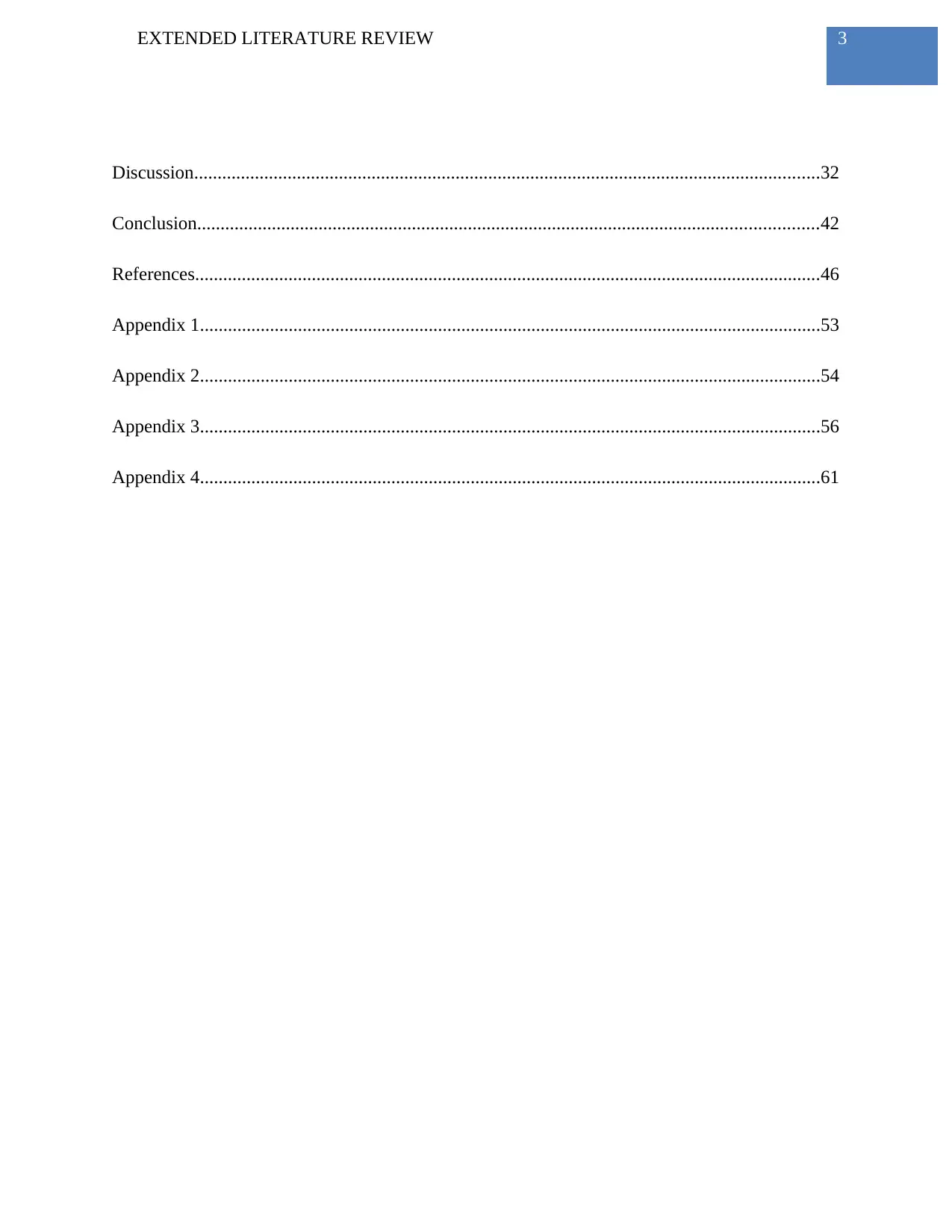
3EXTENDED LITERATURE REVIEW
Discussion......................................................................................................................................32
Conclusion.....................................................................................................................................42
References......................................................................................................................................46
Appendix 1.....................................................................................................................................53
Appendix 2.....................................................................................................................................54
Appendix 3.....................................................................................................................................56
Appendix 4.....................................................................................................................................61
Discussion......................................................................................................................................32
Conclusion.....................................................................................................................................42
References......................................................................................................................................46
Appendix 1.....................................................................................................................................53
Appendix 2.....................................................................................................................................54
Appendix 3.....................................................................................................................................56
Appendix 4.....................................................................................................................................61
Paraphrase This Document
Need a fresh take? Get an instant paraphrase of this document with our AI Paraphraser
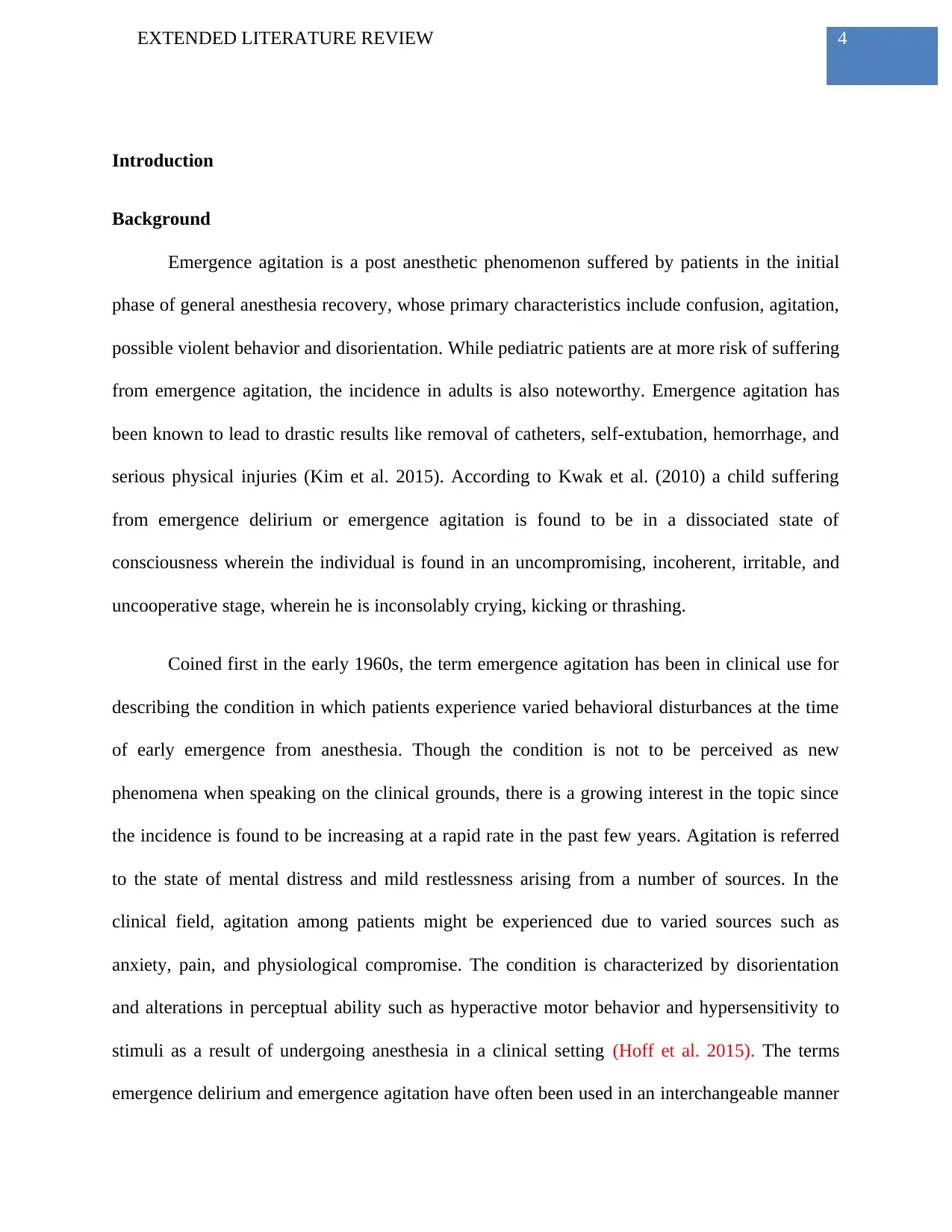
4EXTENDED LITERATURE REVIEW
Introduction
Background
Emergence agitation is a post anesthetic phenomenon suffered by patients in the initial
phase of general anesthesia recovery, whose primary characteristics include confusion, agitation,
possible violent behavior and disorientation. While pediatric patients are at more risk of suffering
from emergence agitation, the incidence in adults is also noteworthy. Emergence agitation has
been known to lead to drastic results like removal of catheters, self-extubation, hemorrhage, and
serious physical injuries (Kim et al. 2015). According to Kwak et al. (2010) a child suffering
from emergence delirium or emergence agitation is found to be in a dissociated state of
consciousness wherein the individual is found in an uncompromising, incoherent, irritable, and
uncooperative stage, wherein he is inconsolably crying, kicking or thrashing.
Coined first in the early 1960s, the term emergence agitation has been in clinical use for
describing the condition in which patients experience varied behavioral disturbances at the time
of early emergence from anesthesia. Though the condition is not to be perceived as new
phenomena when speaking on the clinical grounds, there is a growing interest in the topic since
the incidence is found to be increasing at a rapid rate in the past few years. Agitation is referred
to the state of mental distress and mild restlessness arising from a number of sources. In the
clinical field, agitation among patients might be experienced due to varied sources such as
anxiety, pain, and physiological compromise. The condition is characterized by disorientation
and alterations in perceptual ability such as hyperactive motor behavior and hypersensitivity to
stimuli as a result of undergoing anesthesia in a clinical setting (Hoff et al. 2015). The terms
emergence delirium and emergence agitation have often been used in an interchangeable manner
Introduction
Background
Emergence agitation is a post anesthetic phenomenon suffered by patients in the initial
phase of general anesthesia recovery, whose primary characteristics include confusion, agitation,
possible violent behavior and disorientation. While pediatric patients are at more risk of suffering
from emergence agitation, the incidence in adults is also noteworthy. Emergence agitation has
been known to lead to drastic results like removal of catheters, self-extubation, hemorrhage, and
serious physical injuries (Kim et al. 2015). According to Kwak et al. (2010) a child suffering
from emergence delirium or emergence agitation is found to be in a dissociated state of
consciousness wherein the individual is found in an uncompromising, incoherent, irritable, and
uncooperative stage, wherein he is inconsolably crying, kicking or thrashing.
Coined first in the early 1960s, the term emergence agitation has been in clinical use for
describing the condition in which patients experience varied behavioral disturbances at the time
of early emergence from anesthesia. Though the condition is not to be perceived as new
phenomena when speaking on the clinical grounds, there is a growing interest in the topic since
the incidence is found to be increasing at a rapid rate in the past few years. Agitation is referred
to the state of mental distress and mild restlessness arising from a number of sources. In the
clinical field, agitation among patients might be experienced due to varied sources such as
anxiety, pain, and physiological compromise. The condition is characterized by disorientation
and alterations in perceptual ability such as hyperactive motor behavior and hypersensitivity to
stimuli as a result of undergoing anesthesia in a clinical setting (Hoff et al. 2015). The terms
emergence delirium and emergence agitation have often been used in an interchangeable manner
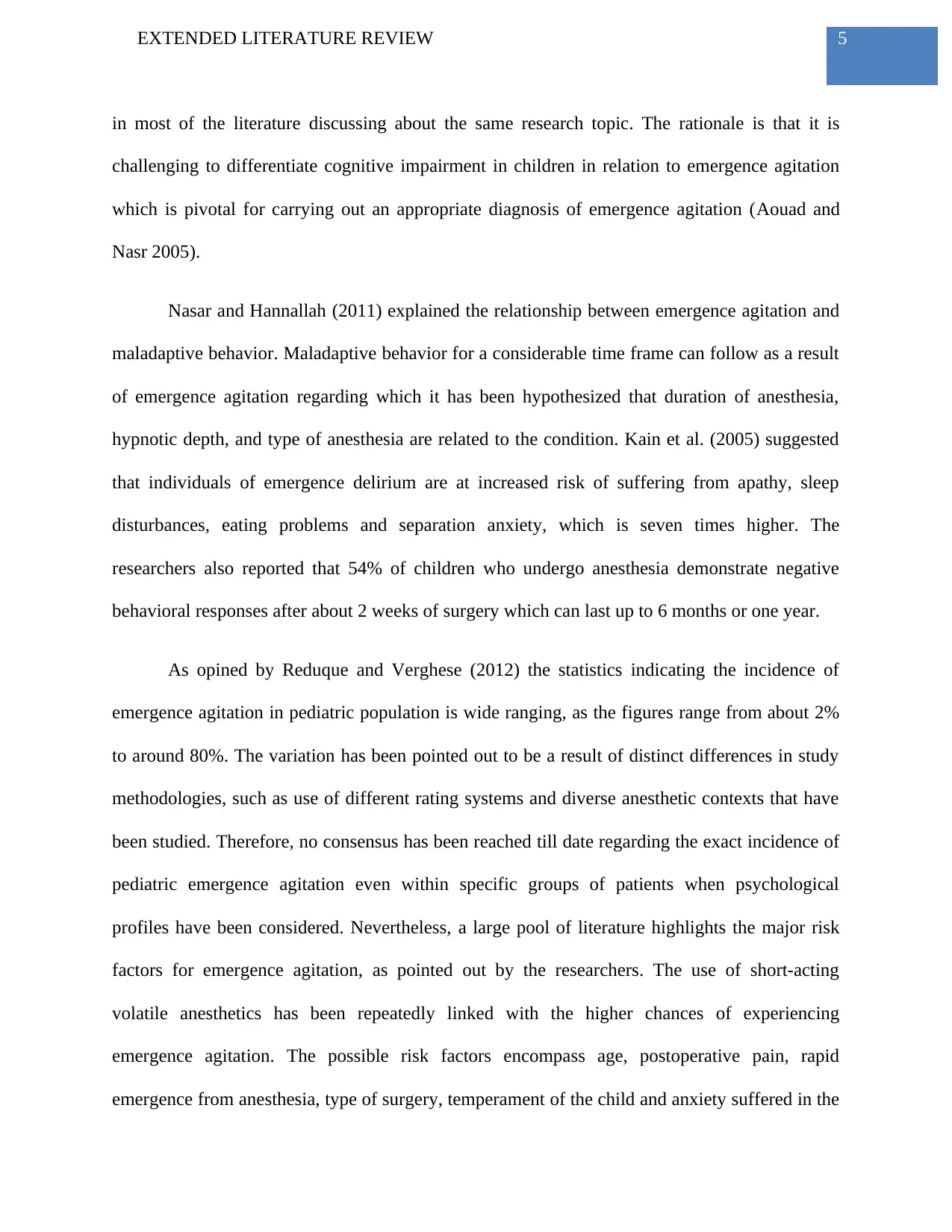
5EXTENDED LITERATURE REVIEW
in most of the literature discussing about the same research topic. The rationale is that it is
challenging to differentiate cognitive impairment in children in relation to emergence agitation
which is pivotal for carrying out an appropriate diagnosis of emergence agitation (Aouad and
Nasr 2005).
Nasar and Hannallah (2011) explained the relationship between emergence agitation and
maladaptive behavior. Maladaptive behavior for a considerable time frame can follow as a result
of emergence agitation regarding which it has been hypothesized that duration of anesthesia,
hypnotic depth, and type of anesthesia are related to the condition. Kain et al. (2005) suggested
that individuals of emergence delirium are at increased risk of suffering from apathy, sleep
disturbances, eating problems and separation anxiety, which is seven times higher. The
researchers also reported that 54% of children who undergo anesthesia demonstrate negative
behavioral responses after about 2 weeks of surgery which can last up to 6 months or one year.
As opined by Reduque and Verghese (2012) the statistics indicating the incidence of
emergence agitation in pediatric population is wide ranging, as the figures range from about 2%
to around 80%. The variation has been pointed out to be a result of distinct differences in study
methodologies, such as use of different rating systems and diverse anesthetic contexts that have
been studied. Therefore, no consensus has been reached till date regarding the exact incidence of
pediatric emergence agitation even within specific groups of patients when psychological
profiles have been considered. Nevertheless, a large pool of literature highlights the major risk
factors for emergence agitation, as pointed out by the researchers. The use of short-acting
volatile anesthetics has been repeatedly linked with the higher chances of experiencing
emergence agitation. The possible risk factors encompass age, postoperative pain, rapid
emergence from anesthesia, type of surgery, temperament of the child and anxiety suffered in the
in most of the literature discussing about the same research topic. The rationale is that it is
challenging to differentiate cognitive impairment in children in relation to emergence agitation
which is pivotal for carrying out an appropriate diagnosis of emergence agitation (Aouad and
Nasr 2005).
Nasar and Hannallah (2011) explained the relationship between emergence agitation and
maladaptive behavior. Maladaptive behavior for a considerable time frame can follow as a result
of emergence agitation regarding which it has been hypothesized that duration of anesthesia,
hypnotic depth, and type of anesthesia are related to the condition. Kain et al. (2005) suggested
that individuals of emergence delirium are at increased risk of suffering from apathy, sleep
disturbances, eating problems and separation anxiety, which is seven times higher. The
researchers also reported that 54% of children who undergo anesthesia demonstrate negative
behavioral responses after about 2 weeks of surgery which can last up to 6 months or one year.
As opined by Reduque and Verghese (2012) the statistics indicating the incidence of
emergence agitation in pediatric population is wide ranging, as the figures range from about 2%
to around 80%. The variation has been pointed out to be a result of distinct differences in study
methodologies, such as use of different rating systems and diverse anesthetic contexts that have
been studied. Therefore, no consensus has been reached till date regarding the exact incidence of
pediatric emergence agitation even within specific groups of patients when psychological
profiles have been considered. Nevertheless, a large pool of literature highlights the major risk
factors for emergence agitation, as pointed out by the researchers. The use of short-acting
volatile anesthetics has been repeatedly linked with the higher chances of experiencing
emergence agitation. The possible risk factors encompass age, postoperative pain, rapid
emergence from anesthesia, type of surgery, temperament of the child and anxiety suffered in the
⊘ This is a preview!⊘
Do you want full access?
Subscribe today to unlock all pages.

Trusted by 1+ million students worldwide
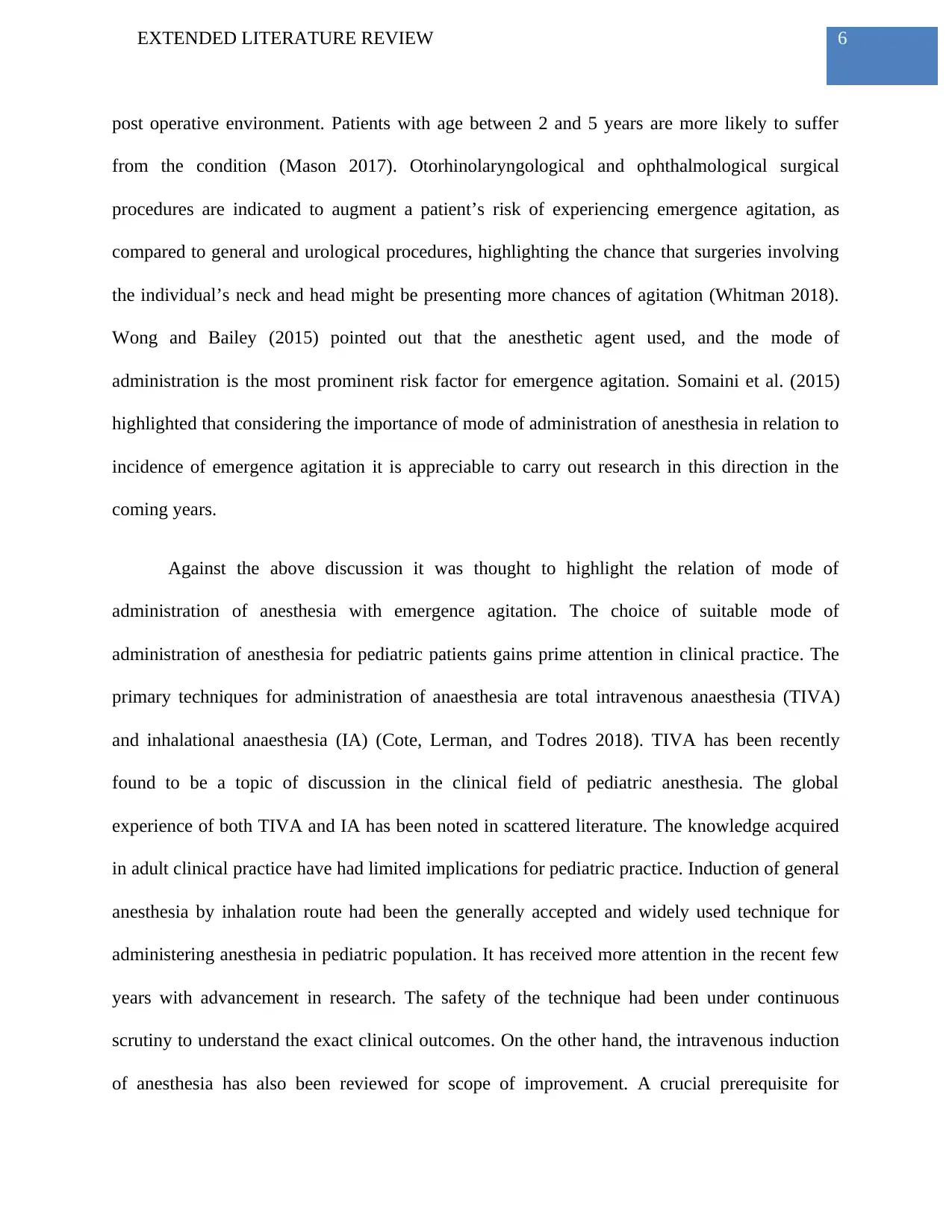
6EXTENDED LITERATURE REVIEW
post operative environment. Patients with age between 2 and 5 years are more likely to suffer
from the condition (Mason 2017). Otorhinolaryngological and ophthalmological surgical
procedures are indicated to augment a patient’s risk of experiencing emergence agitation, as
compared to general and urological procedures, highlighting the chance that surgeries involving
the individual’s neck and head might be presenting more chances of agitation (Whitman 2018).
Wong and Bailey (2015) pointed out that the anesthetic agent used, and the mode of
administration is the most prominent risk factor for emergence agitation. Somaini et al. (2015)
highlighted that considering the importance of mode of administration of anesthesia in relation to
incidence of emergence agitation it is appreciable to carry out research in this direction in the
coming years.
Against the above discussion it was thought to highlight the relation of mode of
administration of anesthesia with emergence agitation. The choice of suitable mode of
administration of anesthesia for pediatric patients gains prime attention in clinical practice. The
primary techniques for administration of anaesthesia are total intravenous anaesthesia (TIVA)
and inhalational anaesthesia (IA) (Cote, Lerman, and Todres 2018). TIVA has been recently
found to be a topic of discussion in the clinical field of pediatric anesthesia. The global
experience of both TIVA and IA has been noted in scattered literature. The knowledge acquired
in adult clinical practice have had limited implications for pediatric practice. Induction of general
anesthesia by inhalation route had been the generally accepted and widely used technique for
administering anesthesia in pediatric population. It has received more attention in the recent few
years with advancement in research. The safety of the technique had been under continuous
scrutiny to understand the exact clinical outcomes. On the other hand, the intravenous induction
of anesthesia has also been reviewed for scope of improvement. A crucial prerequisite for
post operative environment. Patients with age between 2 and 5 years are more likely to suffer
from the condition (Mason 2017). Otorhinolaryngological and ophthalmological surgical
procedures are indicated to augment a patient’s risk of experiencing emergence agitation, as
compared to general and urological procedures, highlighting the chance that surgeries involving
the individual’s neck and head might be presenting more chances of agitation (Whitman 2018).
Wong and Bailey (2015) pointed out that the anesthetic agent used, and the mode of
administration is the most prominent risk factor for emergence agitation. Somaini et al. (2015)
highlighted that considering the importance of mode of administration of anesthesia in relation to
incidence of emergence agitation it is appreciable to carry out research in this direction in the
coming years.
Against the above discussion it was thought to highlight the relation of mode of
administration of anesthesia with emergence agitation. The choice of suitable mode of
administration of anesthesia for pediatric patients gains prime attention in clinical practice. The
primary techniques for administration of anaesthesia are total intravenous anaesthesia (TIVA)
and inhalational anaesthesia (IA) (Cote, Lerman, and Todres 2018). TIVA has been recently
found to be a topic of discussion in the clinical field of pediatric anesthesia. The global
experience of both TIVA and IA has been noted in scattered literature. The knowledge acquired
in adult clinical practice have had limited implications for pediatric practice. Induction of general
anesthesia by inhalation route had been the generally accepted and widely used technique for
administering anesthesia in pediatric population. It has received more attention in the recent few
years with advancement in research. The safety of the technique had been under continuous
scrutiny to understand the exact clinical outcomes. On the other hand, the intravenous induction
of anesthesia has also been reviewed for scope of improvement. A crucial prerequisite for
Paraphrase This Document
Need a fresh take? Get an instant paraphrase of this document with our AI Paraphraser
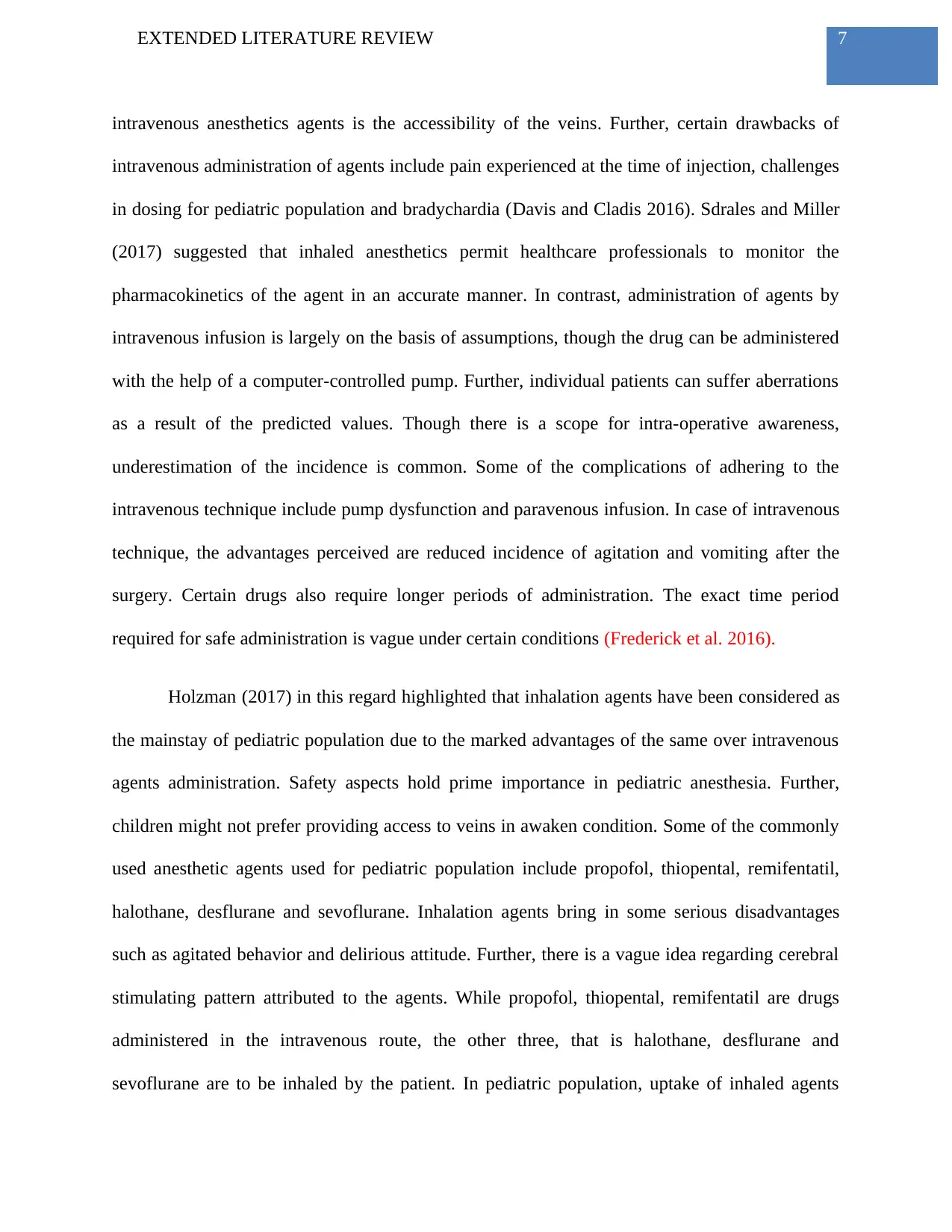
7EXTENDED LITERATURE REVIEW
intravenous anesthetics agents is the accessibility of the veins. Further, certain drawbacks of
intravenous administration of agents include pain experienced at the time of injection, challenges
in dosing for pediatric population and bradychardia (Davis and Cladis 2016). Sdrales and Miller
(2017) suggested that inhaled anesthetics permit healthcare professionals to monitor the
pharmacokinetics of the agent in an accurate manner. In contrast, administration of agents by
intravenous infusion is largely on the basis of assumptions, though the drug can be administered
with the help of a computer-controlled pump. Further, individual patients can suffer aberrations
as a result of the predicted values. Though there is a scope for intra-operative awareness,
underestimation of the incidence is common. Some of the complications of adhering to the
intravenous technique include pump dysfunction and paravenous infusion. In case of intravenous
technique, the advantages perceived are reduced incidence of agitation and vomiting after the
surgery. Certain drugs also require longer periods of administration. The exact time period
required for safe administration is vague under certain conditions (Frederick et al. 2016).
Holzman (2017) in this regard highlighted that inhalation agents have been considered as
the mainstay of pediatric population due to the marked advantages of the same over intravenous
agents administration. Safety aspects hold prime importance in pediatric anesthesia. Further,
children might not prefer providing access to veins in awaken condition. Some of the commonly
used anesthetic agents used for pediatric population include propofol, thiopental, remifentatil,
halothane, desflurane and sevoflurane. Inhalation agents bring in some serious disadvantages
such as agitated behavior and delirious attitude. Further, there is a vague idea regarding cerebral
stimulating pattern attributed to the agents. While propofol, thiopental, remifentatil are drugs
administered in the intravenous route, the other three, that is halothane, desflurane and
sevoflurane are to be inhaled by the patient. In pediatric population, uptake of inhaled agents
intravenous anesthetics agents is the accessibility of the veins. Further, certain drawbacks of
intravenous administration of agents include pain experienced at the time of injection, challenges
in dosing for pediatric population and bradychardia (Davis and Cladis 2016). Sdrales and Miller
(2017) suggested that inhaled anesthetics permit healthcare professionals to monitor the
pharmacokinetics of the agent in an accurate manner. In contrast, administration of agents by
intravenous infusion is largely on the basis of assumptions, though the drug can be administered
with the help of a computer-controlled pump. Further, individual patients can suffer aberrations
as a result of the predicted values. Though there is a scope for intra-operative awareness,
underestimation of the incidence is common. Some of the complications of adhering to the
intravenous technique include pump dysfunction and paravenous infusion. In case of intravenous
technique, the advantages perceived are reduced incidence of agitation and vomiting after the
surgery. Certain drugs also require longer periods of administration. The exact time period
required for safe administration is vague under certain conditions (Frederick et al. 2016).
Holzman (2017) in this regard highlighted that inhalation agents have been considered as
the mainstay of pediatric population due to the marked advantages of the same over intravenous
agents administration. Safety aspects hold prime importance in pediatric anesthesia. Further,
children might not prefer providing access to veins in awaken condition. Some of the commonly
used anesthetic agents used for pediatric population include propofol, thiopental, remifentatil,
halothane, desflurane and sevoflurane. Inhalation agents bring in some serious disadvantages
such as agitated behavior and delirious attitude. Further, there is a vague idea regarding cerebral
stimulating pattern attributed to the agents. While propofol, thiopental, remifentatil are drugs
administered in the intravenous route, the other three, that is halothane, desflurane and
sevoflurane are to be inhaled by the patient. In pediatric population, uptake of inhaled agents
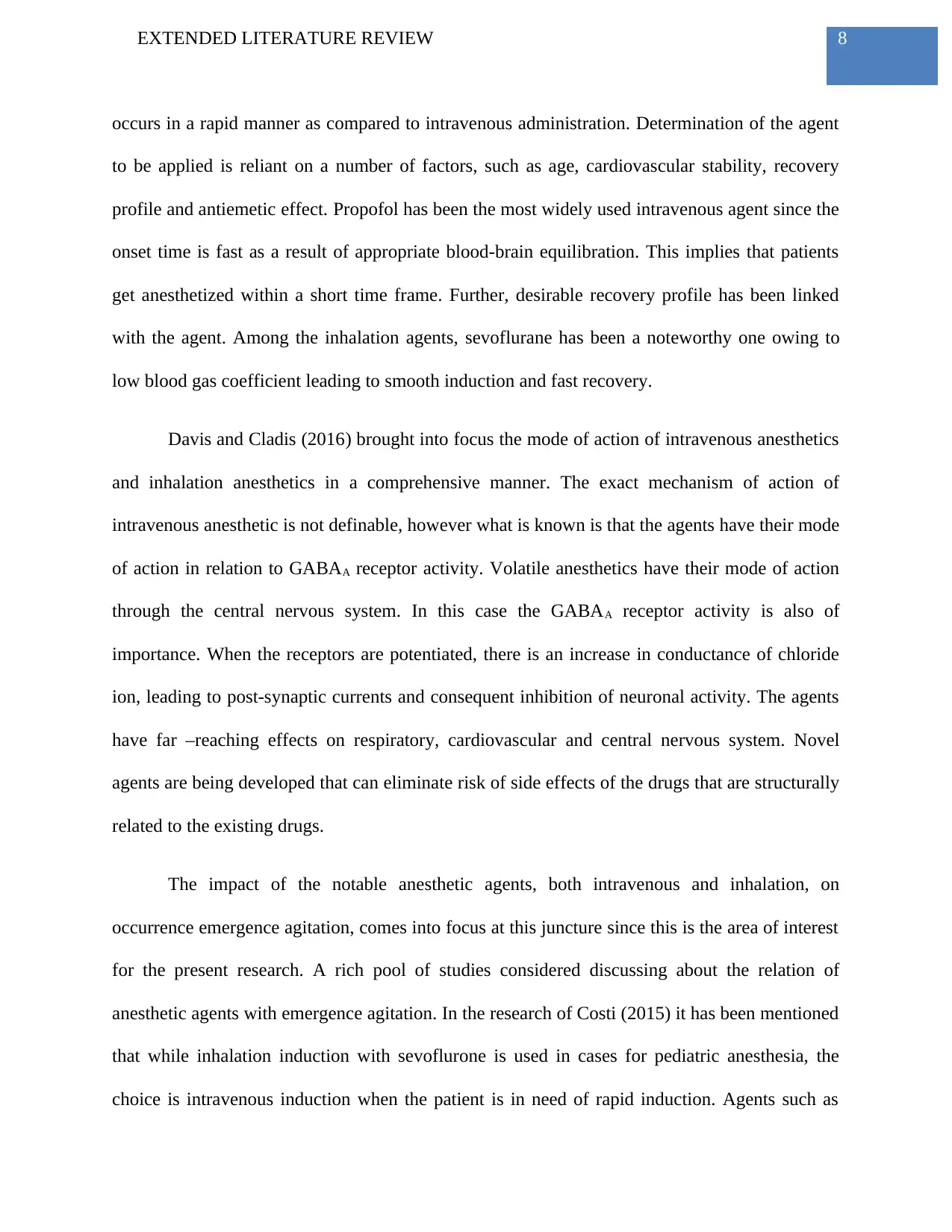
8EXTENDED LITERATURE REVIEW
occurs in a rapid manner as compared to intravenous administration. Determination of the agent
to be applied is reliant on a number of factors, such as age, cardiovascular stability, recovery
profile and antiemetic effect. Propofol has been the most widely used intravenous agent since the
onset time is fast as a result of appropriate blood-brain equilibration. This implies that patients
get anesthetized within a short time frame. Further, desirable recovery profile has been linked
with the agent. Among the inhalation agents, sevoflurane has been a noteworthy one owing to
low blood gas coefficient leading to smooth induction and fast recovery.
Davis and Cladis (2016) brought into focus the mode of action of intravenous anesthetics
and inhalation anesthetics in a comprehensive manner. The exact mechanism of action of
intravenous anesthetic is not definable, however what is known is that the agents have their mode
of action in relation to GABAA receptor activity. Volatile anesthetics have their mode of action
through the central nervous system. In this case the GABAA receptor activity is also of
importance. When the receptors are potentiated, there is an increase in conductance of chloride
ion, leading to post-synaptic currents and consequent inhibition of neuronal activity. The agents
have far –reaching effects on respiratory, cardiovascular and central nervous system. Novel
agents are being developed that can eliminate risk of side effects of the drugs that are structurally
related to the existing drugs.
The impact of the notable anesthetic agents, both intravenous and inhalation, on
occurrence emergence agitation, comes into focus at this juncture since this is the area of interest
for the present research. A rich pool of studies considered discussing about the relation of
anesthetic agents with emergence agitation. In the research of Costi (2015) it has been mentioned
that while inhalation induction with sevoflurone is used in cases for pediatric anesthesia, the
choice is intravenous induction when the patient is in need of rapid induction. Agents such as
occurs in a rapid manner as compared to intravenous administration. Determination of the agent
to be applied is reliant on a number of factors, such as age, cardiovascular stability, recovery
profile and antiemetic effect. Propofol has been the most widely used intravenous agent since the
onset time is fast as a result of appropriate blood-brain equilibration. This implies that patients
get anesthetized within a short time frame. Further, desirable recovery profile has been linked
with the agent. Among the inhalation agents, sevoflurane has been a noteworthy one owing to
low blood gas coefficient leading to smooth induction and fast recovery.
Davis and Cladis (2016) brought into focus the mode of action of intravenous anesthetics
and inhalation anesthetics in a comprehensive manner. The exact mechanism of action of
intravenous anesthetic is not definable, however what is known is that the agents have their mode
of action in relation to GABAA receptor activity. Volatile anesthetics have their mode of action
through the central nervous system. In this case the GABAA receptor activity is also of
importance. When the receptors are potentiated, there is an increase in conductance of chloride
ion, leading to post-synaptic currents and consequent inhibition of neuronal activity. The agents
have far –reaching effects on respiratory, cardiovascular and central nervous system. Novel
agents are being developed that can eliminate risk of side effects of the drugs that are structurally
related to the existing drugs.
The impact of the notable anesthetic agents, both intravenous and inhalation, on
occurrence emergence agitation, comes into focus at this juncture since this is the area of interest
for the present research. A rich pool of studies considered discussing about the relation of
anesthetic agents with emergence agitation. In the research of Costi (2015) it has been mentioned
that while inhalation induction with sevoflurone is used in cases for pediatric anesthesia, the
choice is intravenous induction when the patient is in need of rapid induction. Agents such as
⊘ This is a preview!⊘
Do you want full access?
Subscribe today to unlock all pages.

Trusted by 1+ million students worldwide
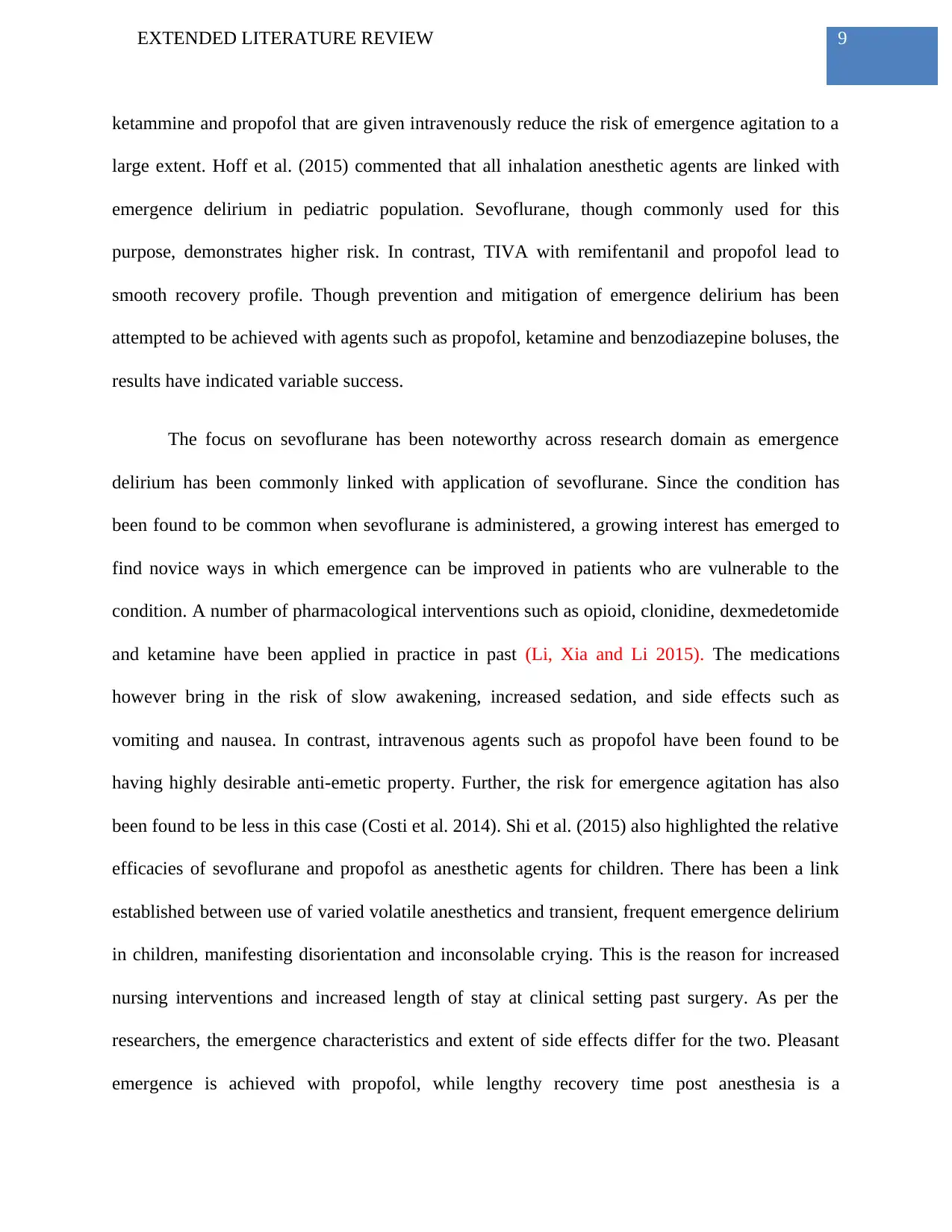
9EXTENDED LITERATURE REVIEW
ketammine and propofol that are given intravenously reduce the risk of emergence agitation to a
large extent. Hoff et al. (2015) commented that all inhalation anesthetic agents are linked with
emergence delirium in pediatric population. Sevoflurane, though commonly used for this
purpose, demonstrates higher risk. In contrast, TIVA with remifentanil and propofol lead to
smooth recovery profile. Though prevention and mitigation of emergence delirium has been
attempted to be achieved with agents such as propofol, ketamine and benzodiazepine boluses, the
results have indicated variable success.
The focus on sevoflurane has been noteworthy across research domain as emergence
delirium has been commonly linked with application of sevoflurane. Since the condition has
been found to be common when sevoflurane is administered, a growing interest has emerged to
find novice ways in which emergence can be improved in patients who are vulnerable to the
condition. A number of pharmacological interventions such as opioid, clonidine, dexmedetomide
and ketamine have been applied in practice in past (Li, Xia and Li 2015). The medications
however bring in the risk of slow awakening, increased sedation, and side effects such as
vomiting and nausea. In contrast, intravenous agents such as propofol have been found to be
having highly desirable anti-emetic property. Further, the risk for emergence agitation has also
been found to be less in this case (Costi et al. 2014). Shi et al. (2015) also highlighted the relative
efficacies of sevoflurane and propofol as anesthetic agents for children. There has been a link
established between use of varied volatile anesthetics and transient, frequent emergence delirium
in children, manifesting disorientation and inconsolable crying. This is the reason for increased
nursing interventions and increased length of stay at clinical setting past surgery. As per the
researchers, the emergence characteristics and extent of side effects differ for the two. Pleasant
emergence is achieved with propofol, while lengthy recovery time post anesthesia is a
ketammine and propofol that are given intravenously reduce the risk of emergence agitation to a
large extent. Hoff et al. (2015) commented that all inhalation anesthetic agents are linked with
emergence delirium in pediatric population. Sevoflurane, though commonly used for this
purpose, demonstrates higher risk. In contrast, TIVA with remifentanil and propofol lead to
smooth recovery profile. Though prevention and mitigation of emergence delirium has been
attempted to be achieved with agents such as propofol, ketamine and benzodiazepine boluses, the
results have indicated variable success.
The focus on sevoflurane has been noteworthy across research domain as emergence
delirium has been commonly linked with application of sevoflurane. Since the condition has
been found to be common when sevoflurane is administered, a growing interest has emerged to
find novice ways in which emergence can be improved in patients who are vulnerable to the
condition. A number of pharmacological interventions such as opioid, clonidine, dexmedetomide
and ketamine have been applied in practice in past (Li, Xia and Li 2015). The medications
however bring in the risk of slow awakening, increased sedation, and side effects such as
vomiting and nausea. In contrast, intravenous agents such as propofol have been found to be
having highly desirable anti-emetic property. Further, the risk for emergence agitation has also
been found to be less in this case (Costi et al. 2014). Shi et al. (2015) also highlighted the relative
efficacies of sevoflurane and propofol as anesthetic agents for children. There has been a link
established between use of varied volatile anesthetics and transient, frequent emergence delirium
in children, manifesting disorientation and inconsolable crying. This is the reason for increased
nursing interventions and increased length of stay at clinical setting past surgery. As per the
researchers, the emergence characteristics and extent of side effects differ for the two. Pleasant
emergence is achieved with propofol, while lengthy recovery time post anesthesia is a
Paraphrase This Document
Need a fresh take? Get an instant paraphrase of this document with our AI Paraphraser
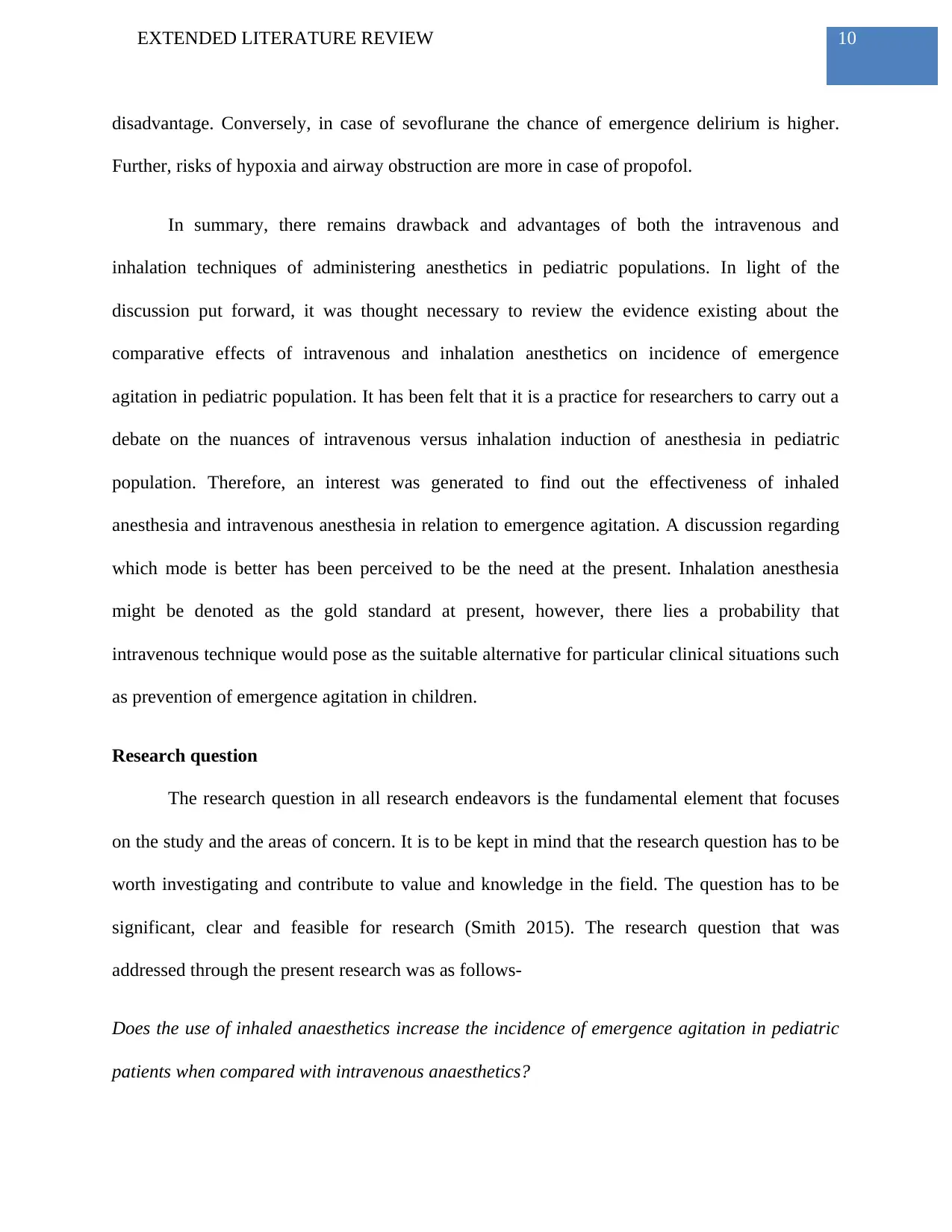
10EXTENDED LITERATURE REVIEW
disadvantage. Conversely, in case of sevoflurane the chance of emergence delirium is higher.
Further, risks of hypoxia and airway obstruction are more in case of propofol.
In summary, there remains drawback and advantages of both the intravenous and
inhalation techniques of administering anesthetics in pediatric populations. In light of the
discussion put forward, it was thought necessary to review the evidence existing about the
comparative effects of intravenous and inhalation anesthetics on incidence of emergence
agitation in pediatric population. It has been felt that it is a practice for researchers to carry out a
debate on the nuances of intravenous versus inhalation induction of anesthesia in pediatric
population. Therefore, an interest was generated to find out the effectiveness of inhaled
anesthesia and intravenous anesthesia in relation to emergence agitation. A discussion regarding
which mode is better has been perceived to be the need at the present. Inhalation anesthesia
might be denoted as the gold standard at present, however, there lies a probability that
intravenous technique would pose as the suitable alternative for particular clinical situations such
as prevention of emergence agitation in children.
Research question
The research question in all research endeavors is the fundamental element that focuses
on the study and the areas of concern. It is to be kept in mind that the research question has to be
worth investigating and contribute to value and knowledge in the field. The question has to be
significant, clear and feasible for research (Smith 2015). The research question that was
addressed through the present research was as follows-
Does the use of inhaled anaesthetics increase the incidence of emergence agitation in pediatric
patients when compared with intravenous anaesthetics?
disadvantage. Conversely, in case of sevoflurane the chance of emergence delirium is higher.
Further, risks of hypoxia and airway obstruction are more in case of propofol.
In summary, there remains drawback and advantages of both the intravenous and
inhalation techniques of administering anesthetics in pediatric populations. In light of the
discussion put forward, it was thought necessary to review the evidence existing about the
comparative effects of intravenous and inhalation anesthetics on incidence of emergence
agitation in pediatric population. It has been felt that it is a practice for researchers to carry out a
debate on the nuances of intravenous versus inhalation induction of anesthesia in pediatric
population. Therefore, an interest was generated to find out the effectiveness of inhaled
anesthesia and intravenous anesthesia in relation to emergence agitation. A discussion regarding
which mode is better has been perceived to be the need at the present. Inhalation anesthesia
might be denoted as the gold standard at present, however, there lies a probability that
intravenous technique would pose as the suitable alternative for particular clinical situations such
as prevention of emergence agitation in children.
Research question
The research question in all research endeavors is the fundamental element that focuses
on the study and the areas of concern. It is to be kept in mind that the research question has to be
worth investigating and contribute to value and knowledge in the field. The question has to be
significant, clear and feasible for research (Smith 2015). The research question that was
addressed through the present research was as follows-
Does the use of inhaled anaesthetics increase the incidence of emergence agitation in pediatric
patients when compared with intravenous anaesthetics?
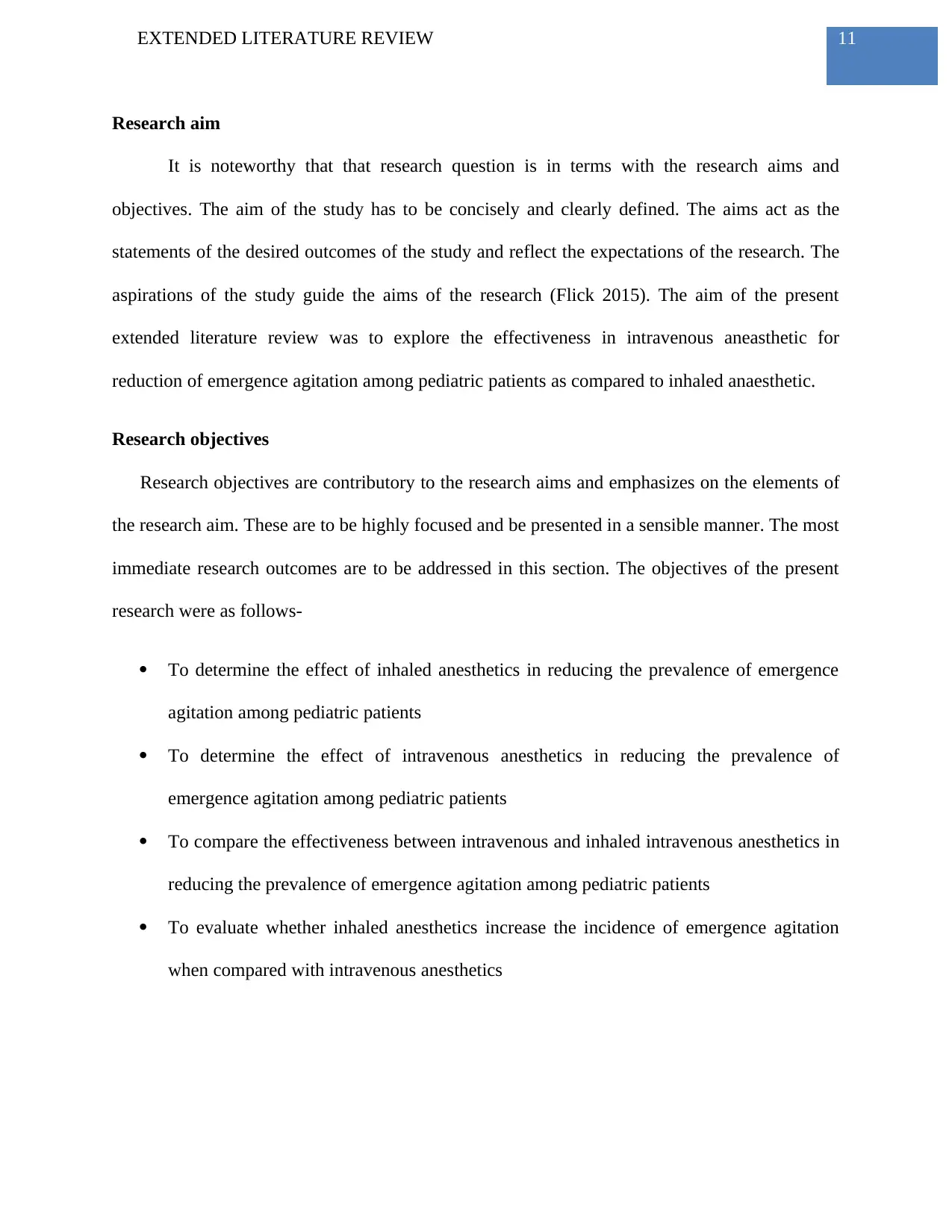
11EXTENDED LITERATURE REVIEW
Research aim
It is noteworthy that that research question is in terms with the research aims and
objectives. The aim of the study has to be concisely and clearly defined. The aims act as the
statements of the desired outcomes of the study and reflect the expectations of the research. The
aspirations of the study guide the aims of the research (Flick 2015). The aim of the present
extended literature review was to explore the effectiveness in intravenous aneasthetic for
reduction of emergence agitation among pediatric patients as compared to inhaled anaesthetic.
Research objectives
Research objectives are contributory to the research aims and emphasizes on the elements of
the research aim. These are to be highly focused and be presented in a sensible manner. The most
immediate research outcomes are to be addressed in this section. The objectives of the present
research were as follows-
To determine the effect of inhaled anesthetics in reducing the prevalence of emergence
agitation among pediatric patients
To determine the effect of intravenous anesthetics in reducing the prevalence of
emergence agitation among pediatric patients
To compare the effectiveness between intravenous and inhaled intravenous anesthetics in
reducing the prevalence of emergence agitation among pediatric patients
To evaluate whether inhaled anesthetics increase the incidence of emergence agitation
when compared with intravenous anesthetics
Research aim
It is noteworthy that that research question is in terms with the research aims and
objectives. The aim of the study has to be concisely and clearly defined. The aims act as the
statements of the desired outcomes of the study and reflect the expectations of the research. The
aspirations of the study guide the aims of the research (Flick 2015). The aim of the present
extended literature review was to explore the effectiveness in intravenous aneasthetic for
reduction of emergence agitation among pediatric patients as compared to inhaled anaesthetic.
Research objectives
Research objectives are contributory to the research aims and emphasizes on the elements of
the research aim. These are to be highly focused and be presented in a sensible manner. The most
immediate research outcomes are to be addressed in this section. The objectives of the present
research were as follows-
To determine the effect of inhaled anesthetics in reducing the prevalence of emergence
agitation among pediatric patients
To determine the effect of intravenous anesthetics in reducing the prevalence of
emergence agitation among pediatric patients
To compare the effectiveness between intravenous and inhaled intravenous anesthetics in
reducing the prevalence of emergence agitation among pediatric patients
To evaluate whether inhaled anesthetics increase the incidence of emergence agitation
when compared with intravenous anesthetics
⊘ This is a preview!⊘
Do you want full access?
Subscribe today to unlock all pages.

Trusted by 1+ million students worldwide
1 out of 71
Related Documents
Your All-in-One AI-Powered Toolkit for Academic Success.
+13062052269
info@desklib.com
Available 24*7 on WhatsApp / Email
![[object Object]](/_next/static/media/star-bottom.7253800d.svg)
Unlock your academic potential
Copyright © 2020–2025 A2Z Services. All Rights Reserved. Developed and managed by ZUCOL.




